How blockchain
will transform
How Blockchain will
the modern
transform the modern
supply chain
supply chain
�
Introduction
Complex supply chains require trust
Contemporary supply chains have opened up a world of connected commerce far beyond what previous
generations imagined possible. But with this comes unprecedented complexity as multiple parties must
cooperate to move goods around the globe. They face new challenges of maintaining visibility into origin,
authenticity, and asset handling as they cross organizational boundaries.
Retailers and manufacturers place a great deal of trust in their upstream suppliers, distributors, and
transportation providers. The quality of their end-customer experiences depends on other organizations’
ability to transfer the right assets, to the right place, at the right time, in the right manner. And if anything
were to go wrong, they must quickly ascertain both the potential end-customer exposure and the fault
point in their supply chain.
Traditional methods for managing shared
processes – such as manual inspections, after-
the-fact audits, and record reconciliation – are
expensive, time-consuming, and error-prone,
levying a "trust tax" on all parties. Modern
supply chains demand a better solution.
Create trust through blockchain
Blockchain technology is uniquely positioned to
help create trust, transparency, and
accountability between many parties in supply
chain scenarios. Blockchain is a secure, shared,
distributed ledger. It can act as a shared data
layer to enable multiple parties to track the
status of an asset as it moves across a custodial
chain and share information on its provenance
and handling in a secure and transparent way.
A 2017 report found that 408 organizations from
64 countries were facing consistent supply chain
visibility challenges:
69% do not have full visibility into their
supply chains
65% experienced at least one supply chain
disruption
41% still rely on Excel spreadsheets to
keep track of supply chain disruptions
While blockchain has gained early recognition for its uses in the financial world, it also offers tremendous
potential in supply chain scenarios. When used in combination with sensor technologies such as IoT and
RFID, blockchain promises network participants unprecedented visibility into even the most complex
supply chains. Blockchain also enables parties to set up pre-arranged “smart contracts” that can be used to
automatically trigger compensation or fines based on compliance with agreed-upon rules for the farming,
manufacturing, and transportation of goods.
�
Blockchain in action
Curious what a blockchain-empowered supply chain really looks like?
Let's take a snapshot of a food supply chain. It’s key to maintain transparency and efficiency between
numerous farmers, manufacturers, retailers, transporters, and more.
And at the end of the supply chain, customers want assurance that their food will be consistent, high-
quality, and is legitimately sourced from providers they want to buy from (such as organic or fair trade
farmers).
Farm 1
Farm 2
Farm 3
Carrier 1
Factory
Wholesaler
Carrier 2
Carrier 3
✓ Organic
✓ Non-GMO
✓ Fair Trade
Regulator
Retailer
Consumer
Microsoft is building blockchain solutions that can attest everything from ingredient
origin and farming techniques, to finished product movement and storage conditions
from farm to fork.
Let’s explore how blockchain is transforming this complex supply chain through:
•
•
Provenance attestations
Environmental monitoring
• Dispute resolution
�
Provenance
attestations
Confidence in the provenance of a product and its component parts
Current state
Consumers are increasingly concerned about
where their products are coming from and how
they are being produced. Fair-trade, conflict-
free, non-GMO, and organic certifications are
highly sought-after and carry the risk of being
faked. Counterfeit products, especially in food
and pharmaceuticals, could be dangerous for
consumers and disastrous for brands that are
discovered selling them.
In the news:
New Zealand’s popular organic
Manuka honey is frequently
counterfeited, necessitating
stringent authenticity tests to retain
consumer confidence
1 in 10 medical products circulating
in low- and middle-income
countries is either substandard or
falsified
Future state
Tracing product inputs and attesting production techniques on the blockchain creates
an immutable record of asset provenance. Organizations can author smart contracts
stipulating what must be performed by upstream participants before they take action
on or custody of a product, and the entire record can be shown to discerning end
customers to prove the veracity of product claims.
Supplier benefit
Retailer benefit
Consumer benefit
Recognition and market
advantage for certifiable,
ethical sourcing practices
Decreased risk of
counterfeit products and
increased brand loyalty
from consumers due to
ability to accurately attest
asset provenance
Increased confidence in
products; increased ability
to discern between
brands based on
alignment with values
�
Blockchain in action:
Provenance attestations
Organizations can trace products from the strip of land they’re grown on through to the
delivery at retail. Farmers who have earned certifications (e.g. Certified Organic) use bags or
bins specifically allocated to them with labels and sensors that can be tracked along the
supply chain. A set amount of food produced by the organic farmer is expected at each stop
along the supply chain, preventing non-organic food from fraudulently entering in. As a
result, farmers are sure to get credit for their farming practices, and consumers get insight
and confidence in the products they’re purchasing.
A set amount of
Certified Organic food is
packed in traceable bins
✓
Farm 1
✓
Farm 2
✓
Farm 3
Carrier 1
The same amount
of food arrives for
processing
Factory
Wholesaler
Carrier 2
Carrier 3
✓ Organic
✓ Non-GMO
✓ Fair Trade
Regulator
Retailer
Consumer
Retailers and consumers have
confidence in food source
�
Environmental
monitoring
Observation of environmental conditions – such as temperature, humidity,
geography, or excessive movement – that could have adverse financial and/or public
safety impacts
Current state
Maintaining the quality and safety of
goods requires ensuring that every party
in a supply chain transports products in
the right conditions. This is especially
important when transporting food and
pharmaceuticals: if goods are not kept at
the right temperature or humidity, there
are risks to consumer safety and
permanent brand damage.
In the news:
Every year, 200 million tons of food
spoil before reaching market, due in
large part to insufficient cold transport
technology
In 2017, The Guardian found evidence
that the UK’s top chicken supplier had
tampered with food safety records,
leading consumers to buy expired
chicken
Future state
Combining blockchain technology with IoT sensors, RFID tags, and other monitoring
technology enables each party in a supply chain to ensure that products are being kept
in agreed-upon conditions and empowers participants to identify and remedy mistakes
in real time.
Supplier benefit
Retailer benefit
Consumer benefit
Real-time visibility into
product handling and a
high-assurance audit log
to ensure contract
conditions have been
fulfilled
Consumer and brand
protection; more efficient
process for finding fault
points and enforcing
contractual penalties.
Increased assurance of
the safety and quality of
goods
�
Blockchain in action:
Environmental monitoring
Organizations can ensure quality and safety of food along the supply chain by
monitoring key criteria, such as temperature and humidity levels. This is made possible by
packing products with IoT-enabled sensors that send temperature and humidity data at
various points along the supply chain, which are recorded on the blockchain. The shared
ledger can be viewed by carriers, factories, wholesalers, retailers, and regulators.
Products are packaged
with IoT-enabled sensors
Farm 1
Farm 2
Farm 3
✓
Wholesaler
Temperature and humidity levels
are recorded on the blockchain
Temperature 10ºC
✓
Humidity 65%
✓
✓
Carrier 1
Temperature 9ºC
Humidity 66%
✓
✓
✓
Carrier 2
✓
Factory
✓
Carrier 3
Regulator
✓
Retailer
✓ Organic
✓ Non-GMO
✓ Fair Trade
Consumer
All information is viewable on
shared ledger so regulatory
bodies can ensure safety
�
Dispute resolution
Attestable audits of activity that can be used to inform decisions such as billing,
contract fulfillment, licensing, fines, or recalls
Current state
In a complex supply chain, things
inevitably won’t always go as planned –
but when supply chain disputes do occur,
it’s critical to resolve them quickly and
transparently. When a member of the
supply chain fails to deliver assets on-
time and in-full, or if the quality of assets
have been compromised en route, they
will likely have to deal with fines – and
look-back auditing in order to identify
fault is both error prone and costly.
In the news:
Walmart is tightening on-time in-full
enforcement in Spring 2018,
implementing fines for suppliers who
do not deliver at least 85% of their
shipments on time
After months of investigation, Chipotle
and the CDC were unable to definitively
identify the source of the infamous
E. coli outbreak
Future state
Using blockchain to record asset provenance, environmental conditions, and transfers in
real-time removes ambiguity and increases accountability. Faster and more transparent
record-keeping means that disputes can be resolved in a fraction of the time.
Furthermore, parties can use blockchain to create smart contracts in which compliance
with preset terms automatically triggers compensation or fines. This will make dispute
resolution hassles a thing of the past.
Supplier benefit
Retailer benefit
Consumer benefit
Ability to undeniably
prove on-time and in-full
delivery
Efficient dispute
resolution when
conditions are not met
Lower frequency of
out-of-stock goods
�
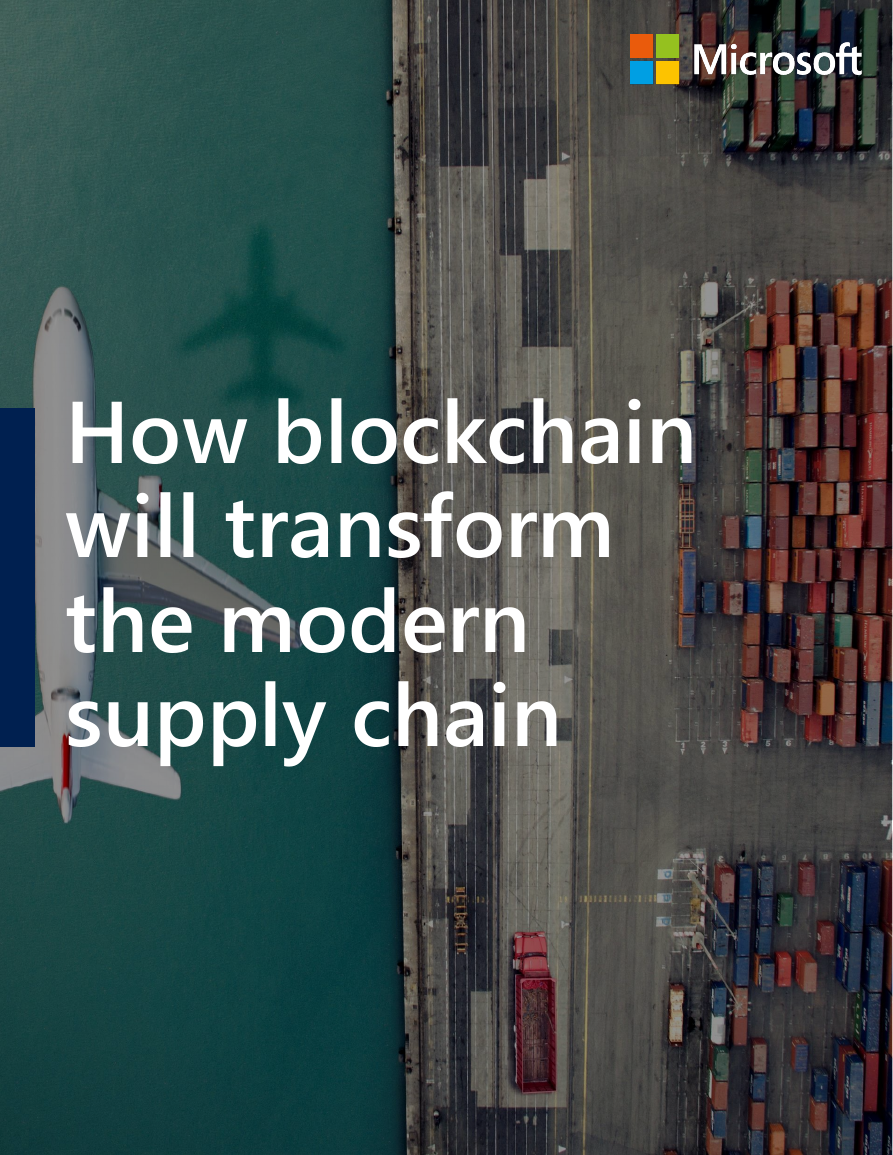
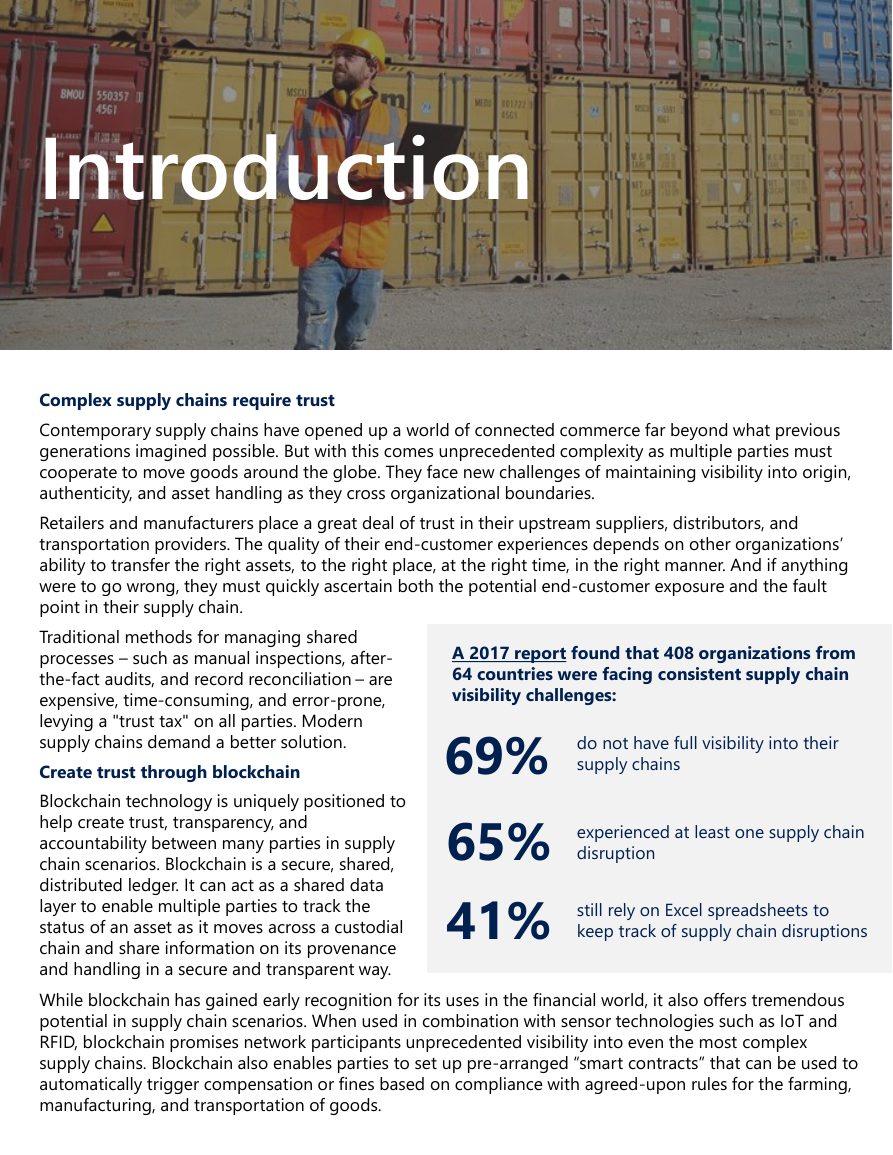

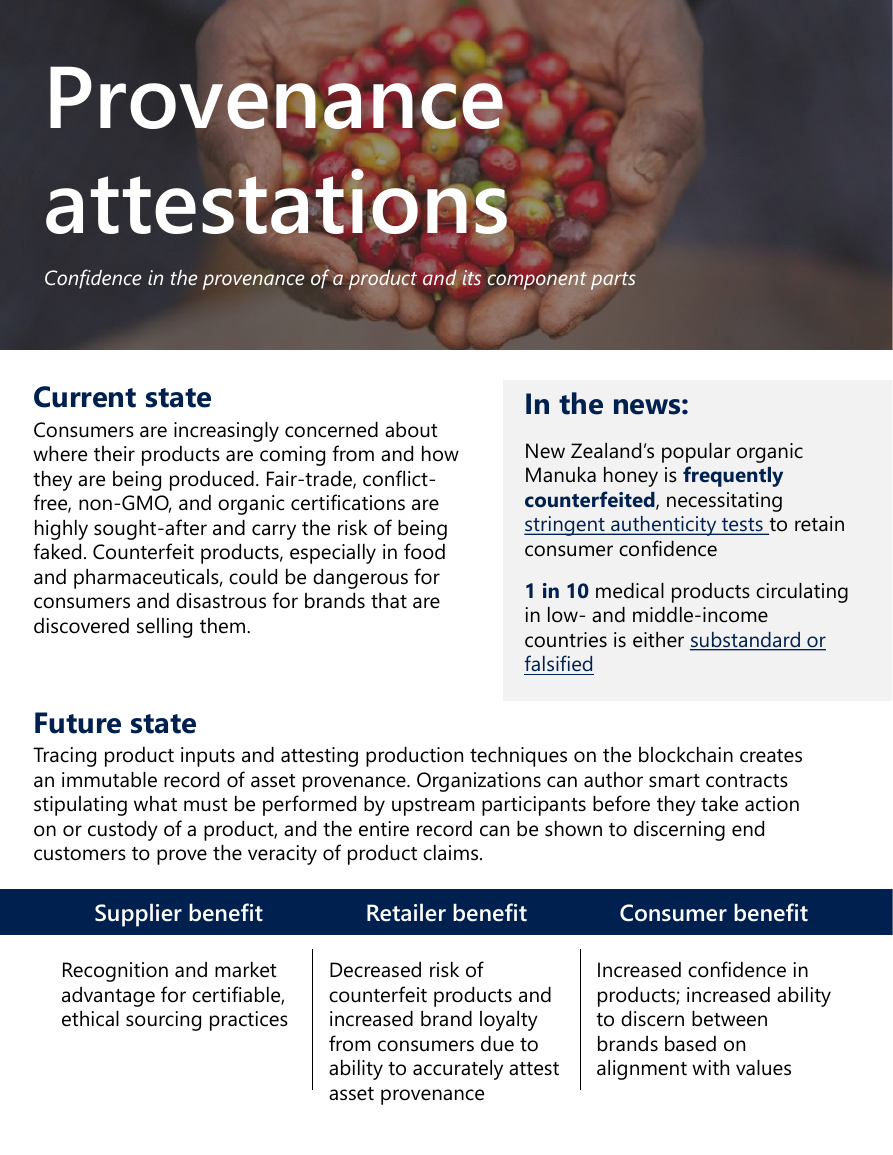

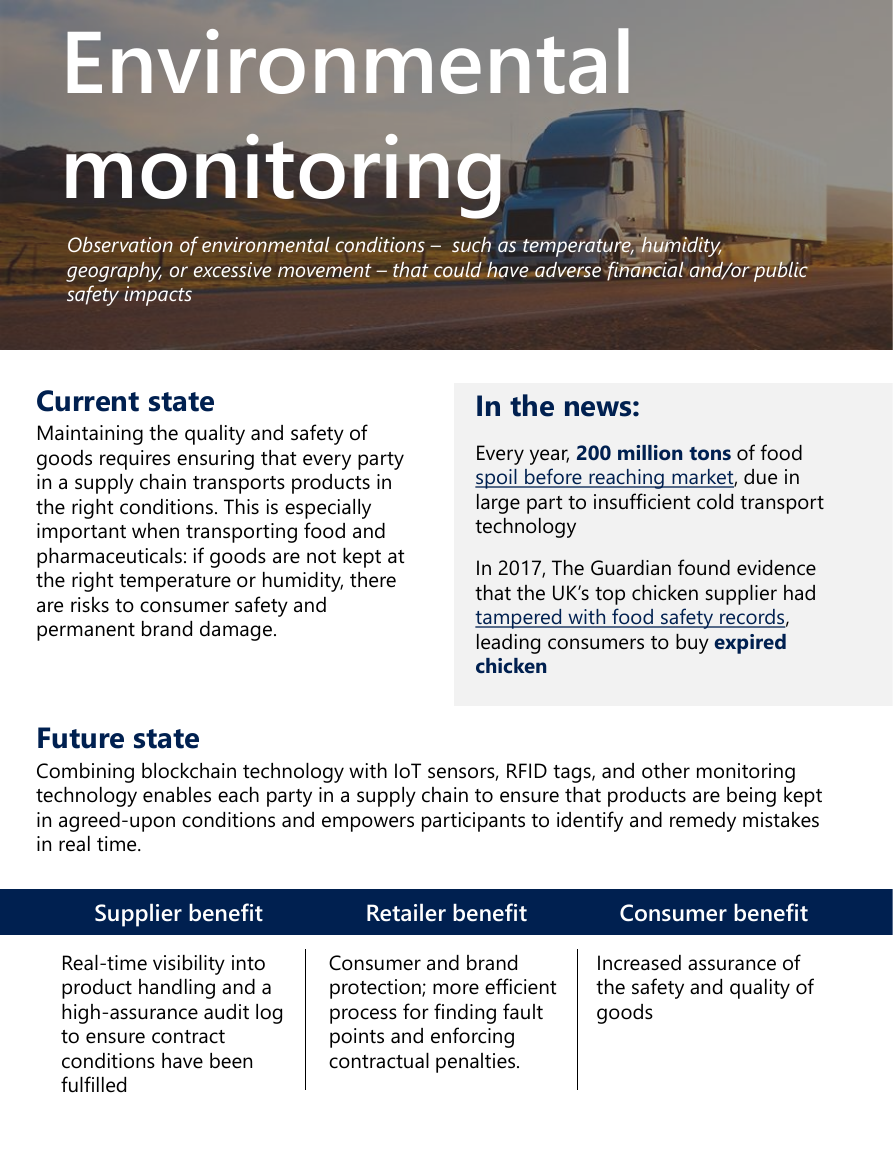

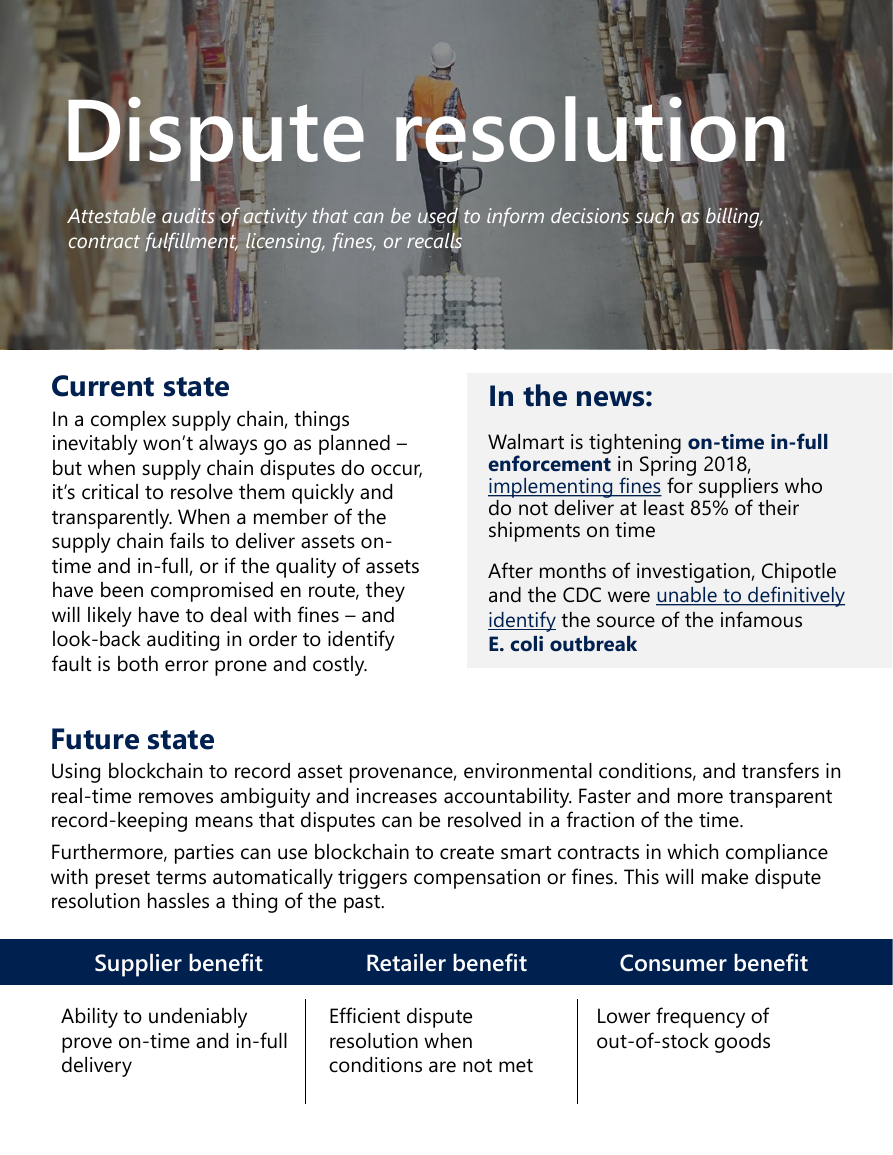








 2023年江西萍乡中考道德与法治真题及答案.doc
2023年江西萍乡中考道德与法治真题及答案.doc 2012年重庆南川中考生物真题及答案.doc
2012年重庆南川中考生物真题及答案.doc 2013年江西师范大学地理学综合及文艺理论基础考研真题.doc
2013年江西师范大学地理学综合及文艺理论基础考研真题.doc 2020年四川甘孜小升初语文真题及答案I卷.doc
2020年四川甘孜小升初语文真题及答案I卷.doc 2020年注册岩土工程师专业基础考试真题及答案.doc
2020年注册岩土工程师专业基础考试真题及答案.doc 2023-2024学年福建省厦门市九年级上学期数学月考试题及答案.doc
2023-2024学年福建省厦门市九年级上学期数学月考试题及答案.doc 2021-2022学年辽宁省沈阳市大东区九年级上学期语文期末试题及答案.doc
2021-2022学年辽宁省沈阳市大东区九年级上学期语文期末试题及答案.doc 2022-2023学年北京东城区初三第一学期物理期末试卷及答案.doc
2022-2023学年北京东城区初三第一学期物理期末试卷及答案.doc 2018上半年江西教师资格初中地理学科知识与教学能力真题及答案.doc
2018上半年江西教师资格初中地理学科知识与教学能力真题及答案.doc 2012年河北国家公务员申论考试真题及答案-省级.doc
2012年河北国家公务员申论考试真题及答案-省级.doc 2020-2021学年江苏省扬州市江都区邵樊片九年级上学期数学第一次质量检测试题及答案.doc
2020-2021学年江苏省扬州市江都区邵樊片九年级上学期数学第一次质量检测试题及答案.doc 2022下半年黑龙江教师资格证中学综合素质真题及答案.doc
2022下半年黑龙江教师资格证中学综合素质真题及答案.doc